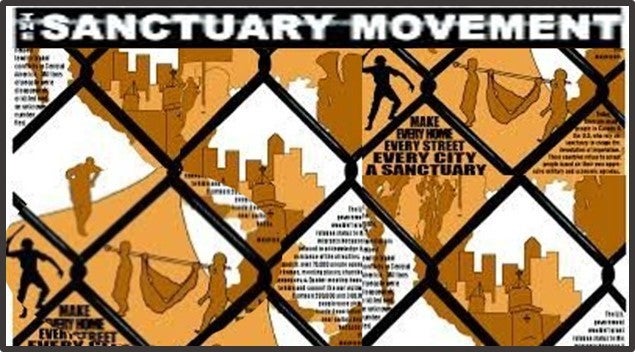
Elliott Young’s article about today’s sanctuary movement (“What Is In a Name,”HuffPost Politics, Nov 30) is inspiring, and I thank him for writing it. It affirms the role of educational institutions in our society as safe havens for ideas, discussion, and most importantly, people. And Emma Lazarus’s poem within the article instills both hope and pride in America’s legacy of inclusion. Yet, if sanctuary is to have any real impact, it has to stand for more than noble ideals.
While there is a long tradition of sanctuary in religious history, dating back to ancient Hebrew criminal codes, it was given new life in the 1980s by activists opposed to U.S. foreign policy in Latin America. For those unfamiliar with this history, a number of churches in the United States declared themselves sanctuary congregations in an effort to aid Latin American refugees.
Activists helped undocumented asylum seekers cross the border with Mexico and housed them in a network of safe homes, some of which were churches, as they made their way north to Canada. The Sanctuary Movement was considered a modern Underground Railroad by those engaged in the effort, and echoes of it remain today.
Once these programs were discovered and enough evidence gathered, Sanctuary Movement organizers were charged with breaking immigration laws and taken to court. In the Merkt/Elder case (794 F.2d 950; 1986), activists made two arguments that can inform today’s sanctuary movement: They asserted that their actions were rooted in deeply held religious convictions and that providing sanctuary to those in need is a mandate of their faith. They also claimed they did not consider their guests “illegal aliens,” but simply political refugees who had not yet been able to gain asylum in our nation’s complex immigration system.
Judicial opinions were readily issued: The activists’ religious freedom claim was denied, based on the test established in Yoder (406 U.S. 205; 1972). The court held that, although the defendants’ beliefs may have been sincere, the law did not place any undue burdens on the religious expression of sanctuary activists. They certainly could have assisted asylum seekers in other ways – by sending donations of food or clothing, for instance. Violating immigration law is not a mandate of any faith tradition. In balancing activists’ rights to act on deeply held convictions against the right of the state to set immigration policy, the courts declared that the state wins: Only the U.S. federal government has the right to establish the nation’s borders and set immigration policy. Acting in defiance of this policy is a punishable offense.
The communities and institutions that declare themselves sanctuaries today should take note of this history. While the religious arguments in Merkt/Elder are of little practical concern to secular organizations, the judgment in this case is clear: Sanctuary has no legal standing, at least not in relation to immigration law. So sanctuary communities must determine whether their declaration will be merely a symbolic statement — a first step in expressing moral outrage — or an act of political resistance.
If sanctuary is simply a moral statement, then it is an empty promise to those we aim to protect. In the fullest sense of the term, sanctuary signals a readiness to engage in civil disobedience. It is a pre-emptive refusal to become an arm of the government to advance unjust laws and policies. Sanctuary is a community’s declaration that it will not contribute to the erosion of our rights to freedom of faith, expression, and assembly. That it will not cooperate if called upon to help dissolve our rights to privacy, due process, and equal protection. In short, a sanctuary community, whether municipal or educational, is essentially putting authorities on notice that it will not cooperate if called upon to become an extension of a surveillance state. And that it is ready and willing to accept the consequences.
Consider a scenario in which a national leader proposes . . . oh, . . . let’s say a registry for religious minorities; a notion that would have been unthinkable little more than a year ago. What would our sanctuary cities, colleges, and universities do if this proposal becomes policy? If they remain true to the spirit of the Sanctuary Movement of the 1980s, they would refuse to implement a registry in their local setting. They would refuse to contribute to it by providing information about members of their community. They would refuse to let federal agents enter to collect either data or people. And they would be willing to pay the penalties – financial or legal – for their failure to comply with this new unjust policy.
Is this what today’s sanctuary communities have in mind? If not, they might consider using new and less potent terms, like “harbor” or “haven.” A declaration of sanctuary in the fullest sense is a pledge to protect the most vulnerable members of our society by safeguarding the ideals, principles, and institutions that we have treasured in America for nearly two and a half centuries. It is a refusal to surrender our ideals to an overly zealous government – come hell, high water, or political expediency.
While recent sanctuary declarations are chock-full of lofty visions and noble ideals, the intention to resist, if necessary, must be behind them. Otherwise, they are only so many words onscreen. Sanctuary is not for the weak-willed or faint-hearted. The stakes are too high for the neighbors and colleagues, friends and loved ones whom we’ve pledged to protect. They are counting on our declarations to have the force of action.
